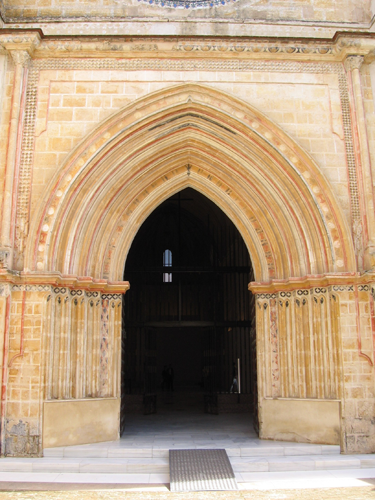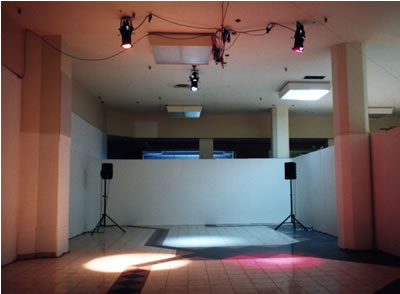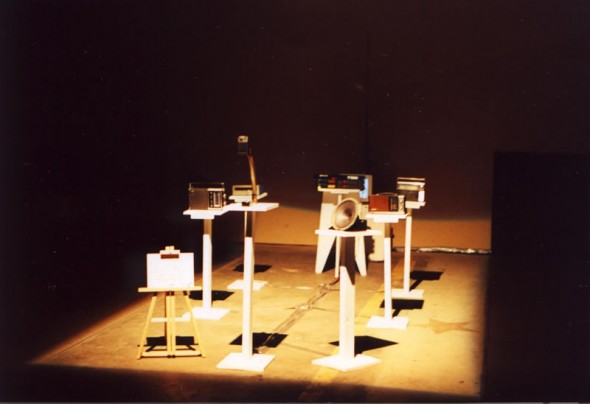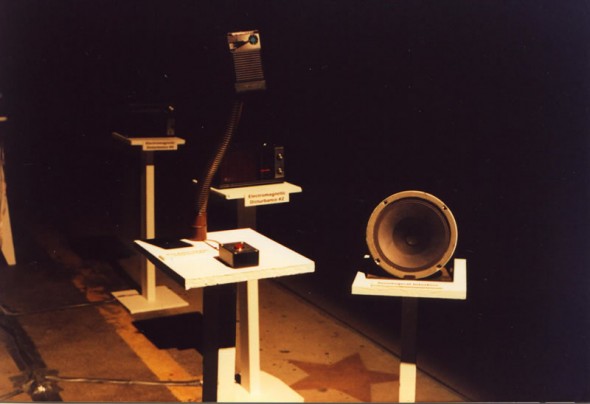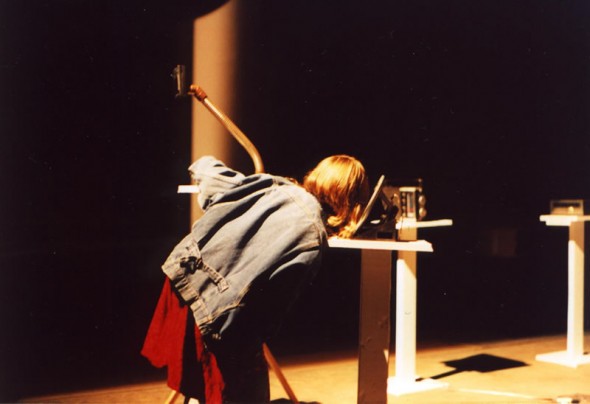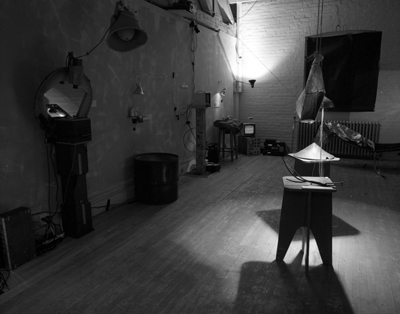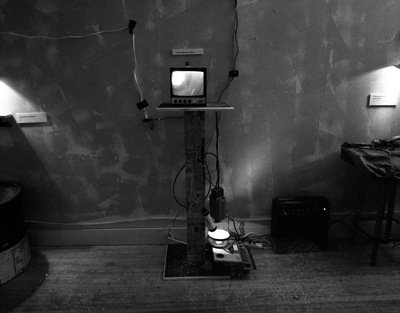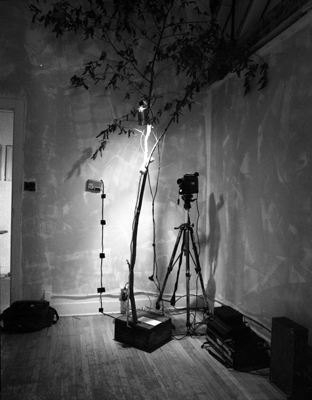Installations
[spacer size=”20″]
[spacer size=”20″]
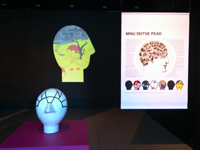 |
[highlight bg=”#222″ color=”#fff”]My Seven Heads[/highlight] (2013) [spacer size=”20″] [spoiler title=”My Seven Heads video”] [media width=”600″ height=”400″ url=”http://www.spinchbeck.com/Audio/my_seven_heads.mp4″] 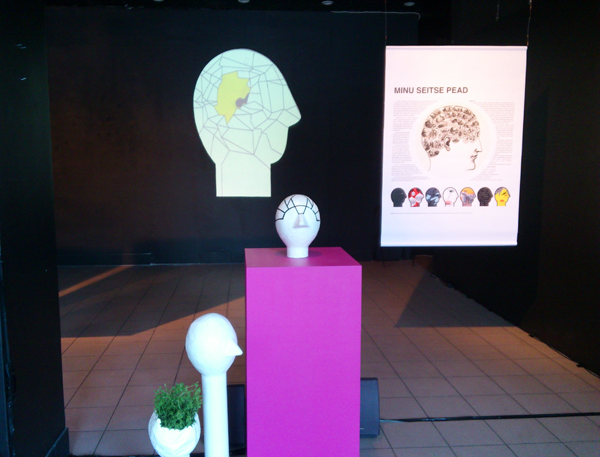 [/spoiler] |
[divider top=1]
 |
[highlight bg=”#222″ color=”#fff”]The Bather[/highlight] (2009) This installation was made in collaboration with Susanna Hood (video), Chris Driedzic (video, sound) and Shawn Pinchbeck (programming, sound, video). It was exhibited at the My Dear Paranoia Exhibit, MARTU, Vaal Galerii, November – December 2009, Tallinn, Estonia and Festival of New Dance – October 2011 in St. John’s, Newfoundland, Canada. [spacer size=”20″] [spoiler title=”The Bather video and pictures”] [media width=”450″ height=”300″ url=”http://www.spinchbeck.com/Audio/TheBather-documentation-ver2-excerpt.mp4″] 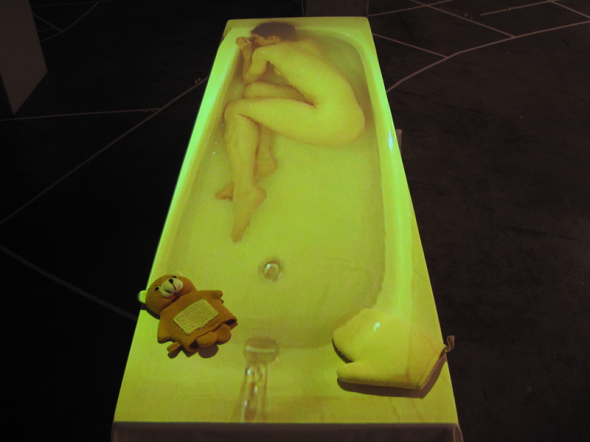 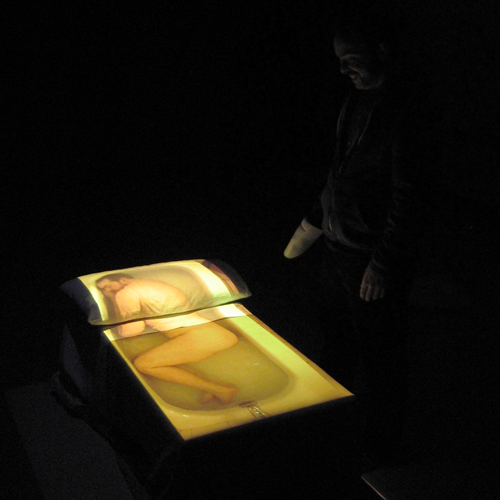 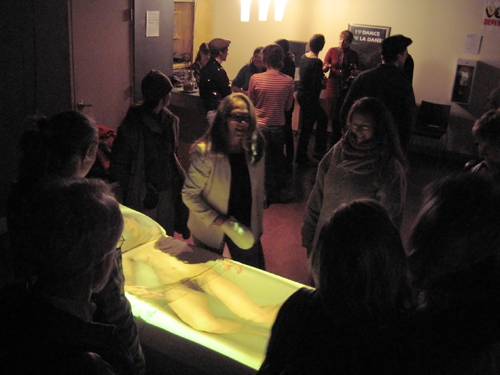 [/spoiler] |
[divider top=1]
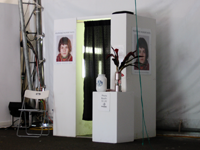 |
[highlight bg=”#222″ color=”#fff”]Polyphonic ID Photo[/highlight] (2008) Polyphonic ID Photo is a computer interactive sound and photo exhibit that takes a photo of the participant, while the photo is being printed, a MIDI Music interpretation of the photo’s RGB values is played.The participant takes the photo with the printed RGB histograms and a web address to the uploaded photo and melody. This piece is a collaboration between Shawn Pinchbeck (audio and video programming), Reimo Võsa-Tangssoo (construction and concept), Sulo Kallas (interface programming). [spacer size=”20″] [spoiler title=”Polyphonic ID Photo audio sample, video and pictures”] [media width=”300″ height=”24″ url=”http://www.spinchbeck.com/Audio/polyphonic-id-photo-audio.mp3″]
[/spoiler] |
[divider top=1]
 |
[highlight bg=”#222″ color=”#fff”]Sidewalk[/highlight] (2006) – Motion Detection, Interactive Audio – concept Liisa Roberts, Hardware and software Shawn Pinchbeck [spacer size=”20″] [spoiler title=”Sidewalk pictures”] 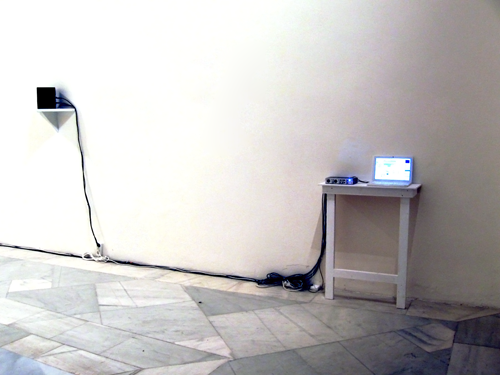 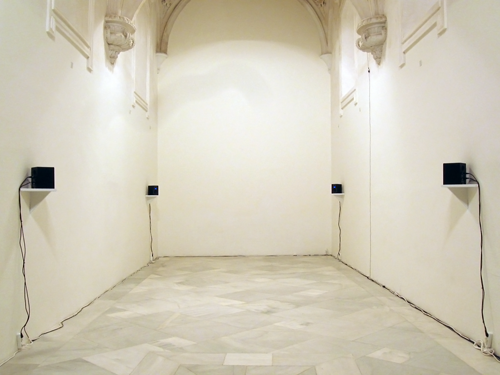
2006 in Centro Andaluz de Arte Contemporáneo, Seville, Spain |
[divider top=1]
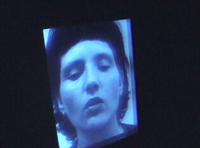 |
[highlight bg=”#222″ color=”#fff”]ID Communication[/highlight] (2004) – Motion Detection, Computer Interactive Video, Collaboration with Ivika Kivi, Dagmar Kase, Shawn Pinchbeck (programming, hardware) [spacer size=”20″] [spoiler title=”Id Communication video”] [media width=”450″ height=”300″ url=”http://www.spinchbeck.com/Audio/idCommunicationsNTSC.mp4″] [/spoiler] |
[divider top=1]
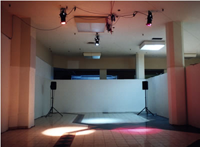 |
[highlight bg=”#222″ color=”#fff”]Sonic Spaces – the kinetics of sound[/highlight] (2003) – Motion Detection, Computer Interactive Audio [spacer size=”20″] [spoiler title=”Sonic Spaces info, pictures and videos”]
Sonic Spaces – (the kinetics of sound) is a computer interactive audio installation. It translates the motion of individuals moving within an active space into a quadraphonic algorithmically controlled soundscape through the use of video camera, computer software, and loudspeakers. Sonic Spaces is intended to be installed into a public space such as a mall, foyer, lobby, art gallery, or other low to middle traffic volume public location. Physically, it consists of a seven metre long by seven metre wide room or area with four loudspeakers positioned in each of the corners of the active space. Directly above the centre of the room are a video camera and three spotlights coloured red, blue and yellow. The camera points straight down to the centre of the room. The spotlights also point down creating three separate coloured areas equidistant from each other surrounding the centre of the room. The associated computer and audio hardware is hidden in a locked room adjacent to the installation. The video camera frames an “active region” of approximately five metres by five metres in the centre of the space that includes the areas lit by the spotlights. As individuals move through this area the motion detection and sound generating software transforms the physical gestures into sonic gestures. Sonic Spaces allows participants a wide range of sonic and performance possibilities so that the experience varies greatly from person to person and from time to time. The simple use of one’s motion as a computer interface allows the installation to be accessible by everyone if they feel the inclination to play and explore. With this work, I want the interactive experience to be rewarding, but not obvious. A one to one “action = reaction” type of experience becomes quickly boring. I want the relationship to the user to be much more complex revealing itself over time enticing individuals to explore further and to become fully engaged in the artwork. The closest analogy would be that Sonic Spaces is a kind of musical instrument that is played by changing one’s spatial position in a room and the characteristics of that motion over time. Several parameters such as duration in a location, velocity of motion, and direction control or influence decisions the software is making about the overall structure and quality of the installation’s sound. Additionally, the software is designed to respond to the presence of more than one person within the space fostering simple collaborations between users. The raw materials for the algorithmic acousmatic composition generated are from pre-recorded sounds digitized on the computer’s hard drive, such as pre-processed computer generated sounds, radio noise, and environmental sounds collected from many natural and urban locations. This library of sound materials are then dynamically processed, resynthesized, mixed and manipulated, to create the resulting quadraphonic soundscape. In some ways, Sonic Spaces is a microcosm of the physical world. We walk down the street and move from place to place with an ever-changing sonic landscape accompanying us. Sonic Spaces is about listening to the environment around you. It attempts to sensitize individuals to this aspect of our daily life. My hope is to bring a sense of creativity and awareness to the motions of people going about their everyday activities when they happen upon this work installed in a public location. Perhaps these individuals will slowdown for a moment to become aware of their bodies and the changing soundspace surrounding them before they continue on with the tasks of their day. Video Documentation The Works Art & Design Festival, Edmonton, Alberta, Canada, June + July, 2003
Requirements and installation info |
[divider top=1]
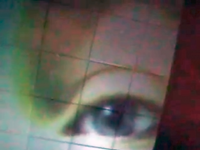 |
[highlight bg=”#222″ color=”#fff”]I Sound – Helisen[/highlight] (2001) – Computer Interactive Audio, Video [spacer size=”20″] [spoiler title=”I Sound – Helisen video”] [media width=”450″ height=”300″ url=”http://www.spinchbeck.com/Audio/I-Sound-Helisen.mp4″] [/spoiler] |
[divider top=1]
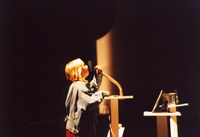 |
[highlight bg=”#222″ color=”#fff”]Electromagnetic Disturbance Redistributer[/highlight] (1998) – Computer Interactive Audio, radio.The “Electromagnetic Disturbance Redistributer” is a computer interactive radio and audio art installation that remixes, processes and recontextualizes AM, FM, and Short-wave radio broadcasts originating from six or more radios in the gallery space. [spacer size=”20″] [spoiler title=”Info, pictures and audio samples”] 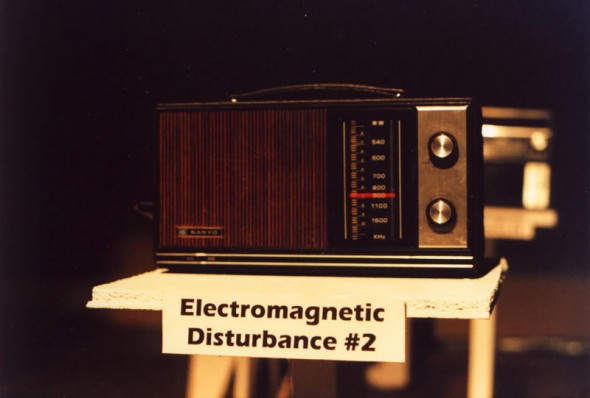 Listen to Electromagnetic Disturbance Redistributer audio examples >> Listen to Electromagnetic Disturbance Redistributer audio examples >>
[media width=”300″ height=”24″ url=”http://www.spinchbeck.com/EMDR/EMDR-1.mp3″] The software is programmed to treat the various radio stations according to their style or content, influencing the strategy the software uses to process each station. For example, music is treated differently from spoken word, as is radio noises, etc. The concept is that the software reorganizes the often bland or irrelevant commercial radio broadcasts into new and interesting contexts and soundscapes, giving them a new lease on life. As an added bonus to the gallery go-er, there is the opportunity to record their own short message to be incorporated into the piece along with the live radio material. This new and improved radio material is then played back through a loudspeaker into the gallery and rebroadcast into the surrounding neighbourhood through the use of low power FM transmitter, or even streamed over the Internet.
[/spoiler] |
[divider top=1]
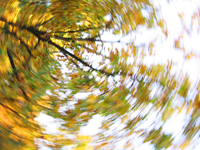 |
[highlight bg=”#222″ color=”#fff”]Talking Trees[/highlight] (1996) – Multimedia – Interactive Sound Sculptures, collaboration with Tim Folkmann and Gary Lee. Talking Trees was an installation that consisted of a room with several trees with telephone receivers in them. There were several that had poems about winter written by Gary Lee, and some that allowed you to speak into the receiver and your altered voice would playback from a speaker in the branches of the tree. [spacer size=”20″] [spoiler title=”Talking trees audio sample”] Listen to the Talking Trees sample>> [media width=”300″ height=”24″ url=”http://www.spinchbeck.com/Audio/Talking-Trees.mp3″] [/spoiler] |
[divider top=1]
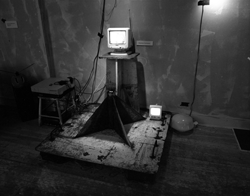 |
[highlight bg=”#222″ color=”#fff”]The Decay of Lying[/highlight] (1996) – Multimedia – video, sculpture, sound, computer interactive, collaboration with Tim Folkmann. The Decay of Lying explored the world of psychic phenomena through the creation of apparati that aided the observer to experience it effects. Through 2 nights of revealments visitors were invited to the Ortona Gallery. [spacer size=”20″] [spoiler title=”The Decay of Lying pictures and video”] [media width=”450″ height=”300″ url=”http://www.spinchbeck.com/Audio/Decay-of-Lying.mp4″]
Photos © Russell Pinchbeck [/spoiler] |
[divider top=1]
| [highlight bg=”#222″ color=”#fff”]Parthenogenesis[/highlight] (1994) – collaborative installation, with Eisert Hall – prints, Shawn Pinchbeck – music, and Bruce Fletcher / Neil Hawkins – video. [spacer size=”20″] No documentation available. |
[divider top=1]




